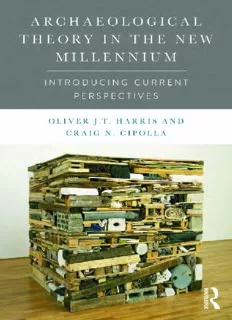
Archaeological Theory in the New Millennium: Introducing Current Perspectives PDF
Preview Archaeological Theory in the New Millennium: Introducing Current Perspectives
ARCHAEOLOGICAL THEORY IN THE NEW MILLENNIUM Archaeological Theory in the New Millennium provides an account of the changing world of archaeological theory and a challenge to more traditional narratives of archaeological thought. It charts the emergence of the new emphasis on relations as well as engaging with other current theoretical trends and the thinkers archaeolo- gists regularly employ. Bringing together different strands of global archaeological theory and placing them in dialogue, the book explores the similarities and dif- ferences between different contemporary trends in theory while also highlighting potential strengths and weaknesses of different approaches. Written in a way to maximise its accessibility, in direct contrast to many of the sources on which it draws, Archaeological Theory in the New Millennium is an essential guide to cutting-edge theory for students and for professionals wishing to reacquaint themselves with this field. Oliver J. T. Harris is Associate Professor of Archaeology in the School of Archaeology and Ancient History, University of Leicester, UK. Craig N. Cipolla is Associate Curator of North American Archaeology, Royal Ontario Museum, Canada. ARCHAEOLOGICAL THEORY IN THE NEW MILLENNIUM Introducing Current Perspectives Oliver J. T. Harris Craig N. Cipolla First published 2017 by Routledge 2 Park Square, Milton Park, Abingdon, Oxon OX14 4RN and by Routledge 711 Third Avenue, New York, NY 10017 Routledge is an imprint of the Taylor & Francis Group, an informa business © 2017 Oliver J. T. Harris and Craig N. Cipolla The right of Oliver J. T. Harris and Craig N. Cipolla to be identified as authors of this work has been asserted by them in accordance with sections 77 and 78 of the Copyright, Designs and Patents Act 1988. All rights reserved. No part of this book may be reprinted or reproduced or utilised in any form or by any electronic, mechanical, or other means, now known or hereafter invented, including photocopying and recording, or in any information storage or retrieval system, without permission in writing from the publishers. Trademark notice: Product or corporate names may be trademarks or registered trademarks, and are used only for identification and explanation without intent to infringe. British Library Cataloguing-in-Publication Data A catalogue record for this book is available from the British Library Library of Congress Cataloging-in-Publication Data Names: Harris, Oliver J.T., author. | Cipolla, Craig N., 1978- co-author. Title: Archaeological theory in the new millennium / Oliver J.T. Harris, Craig N. Cipolla. Description: Milton Park, Abingdon, Oxon ; New York, NY : Routledge, 2017. | Includes bibliographical references and index. Identifiers: LCCN 2016056489 (print) | LCCN 2017017899 (ebook) | ISBN 9781315713250 (E-book) | ISBN 9781138888708 (hardback : alkaline paper) | ISBN 9781138888715 (paperback : alkaline paper) Subjects: LCSH: Archaeology—Philosophy. | Archaeology—Social aspects. | Social change. Classification: LCC CC72 (ebook) | LCC CC72 .H365 2017 (print) | DDC 930.1—dc23 LC record available at https://lccn.loc.gov/2016056489 ISBN: 978-1-138-88870-8 (hbk) ISBN: 978-1-138-88871-5 (pbk) ISBN: 978-1-315-71325-0 (ebk) Typeset in Bembo Std by Swales & Willis Ltd, Exeter, Devon, UK For Sarah, my mother and teacher – OJTH For Maya and Siany – CNC CONTENTS List of figures x List of boxes xii List of tables xiv Acknowledgements xv 1 An introduction to contemporary archaeological theory: confronting dualisms 1 Introduction 1 Beyond paradigms 3 Theory in the new millennium 4 Imagining theory 6 Theory and us 8 Structure of the book 9 2 Beyond paradigms: a potted history of archaeological thought 13 Introduction: understanding a pit with different theories 13 Culture history 16 Processual archaeology 19 Postprocessual archaeology 22 Tracing a history of dualisms 27 The problem with dualisms 31 Conclusions: the three professors 32 3 Between thoughts and things: theorising practice and agency 35 Introduction: encountering the mystery object 35 Theorising practice and agency, or what we do 38 Taking influence from anthropology and sociology 39 viii Contents Archaeologies of practice and agency 44 Reconsidering power, cultural interaction and history 46 Conclusions: some final thoughts on the mystery object 49 4 Situating things in society: identity and personhood 52 Introduction: who were they and who are we? 52 From practice to identity 54 Performing sex and gender 57 Performing personhood 61 Embodied identities 66 Conclusions: identity beyond our assumptions 67 5 Secret lives of things: object agency and biography 71 Introduction: a museum visit 71 Object agency 73 Enchanting the collector 77 Object biography 80 Tracking colonial ‘lives’ 81 Conclusions: back to the museum 85 6 Things make people?: considering materiality, phenomenology, experience and entanglement 87 Introduction: making the Amesbury Archer 87 What is materiality? 89 Dialectics and objectification 90 Phenomenology 95 Experiencing the world 101 Entanglements 104 Conclusions: person makes arrow, arrow makes person 106 7 Mediating the world: archaeological semiotics 109 Introduction: signs in a lonely forest 109 Two sides of Saussure 112 Three cheers for Peirce 116 Archaeological semiotics 120 Conclusions: back to the forest 126 8 Finding symmetry: Actor-Network-Theory and new materialism 129 Introduction: do guns kill people or do people kill people? 129 To modernity, and beyond! The challenge of Bruno Latour 131 Archaeology, the discipline of things 134 From symmetry to new materialism 138 New materialism in archaeology 141 Conclusions: beyond processual and postprocessual archaeologies? 146 Contents ix 9 Multi-species archaeology: people, plants and animals 152 Introduction: archaeology beyond the human 152 Archaeology, plants and animals 154 Thinking about a multi-species world 156 More-than-human archaeology 162 Beyond history versus evolution? 165 Biosemiotics 167 Conclusions: back to domestication 168 10 ‘Others’: postcolonialism, the ontological turn and colonised things 171 Introduction: from stones of Others to stones as Others 171 Postcolonial theory: understanding and representing Others in a shared world 175 New animism and Other worlds 180 In defence of things 185 Conclusions: different approaches to ‘Others’ 188 11 On breaking walls and building relations: a conclusion 193 Introduction 193 A new paradigm? 195 A dialogue between authors 198 Conclusions: together again 212 References 216 Index 235
Description: